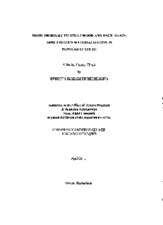| dc.description.abstract | Within the past several years, there has been a resurgence of interest in Jane Austen's life and works. She and her novels have become a part of popular culture through films, written adaptations, and Austen-related commodities. This thesis is an evaluation of the mechanisms (specifically a Jane Austen clock, a Jane Austen pendant, a Regency figure trinket box, the film Clueless, and the novels Bridget Jones's Diary and Bridget Jones: The Edge of Reason) through which interest in Jane Austen has permeated popular culture and the ways in which she and her works have been translated into other media. The project's main focus is not what these films, written adaptations, and objects tell us about Jane Austen, but what they reflect about modern-day commodity culture, about current notions of class and culture (especially "high" culture versus popular/"low" culture), and about how Jane Austen functions as an idea within modern-day notions of culture. Most people seem to understand culture to be divided into high culture and popular/low culture. An evaluation of Jane Austen reveals that she and her works can considered to be representative of high culture. Because she and her works can be seen as symbols of high culture, the market for popular culture items related to her and her works is created, at least in part, by people's desire to be attached to her and her works and to the high culture she represents. Jane Austen's existence in popular culture through these objects, films, and texts provides easier access to her and her works and, subsequently, to society's perception of high culture. | en |


